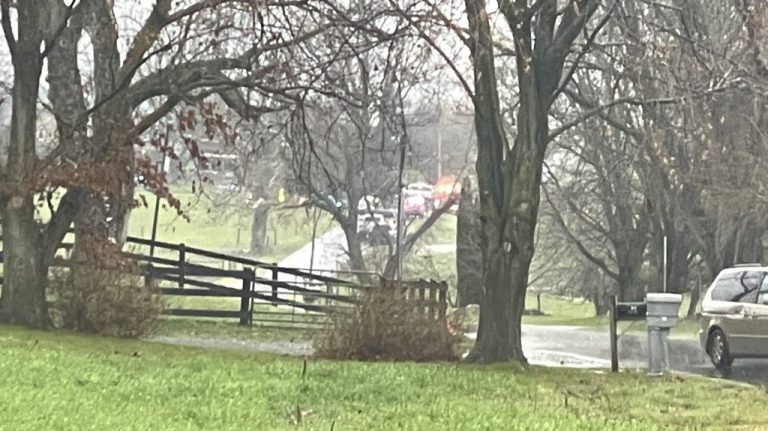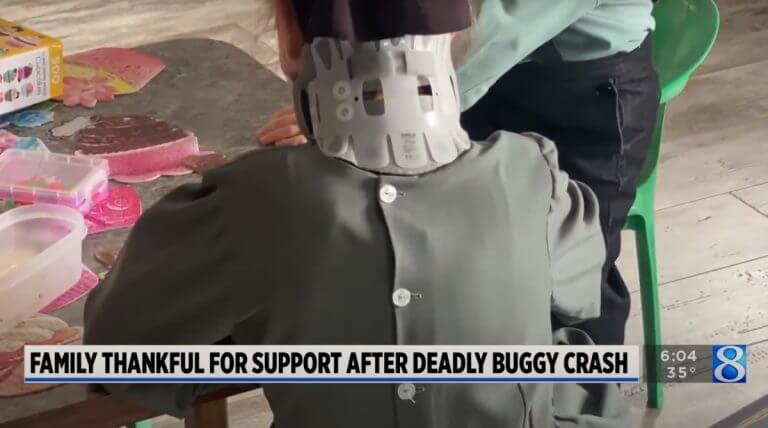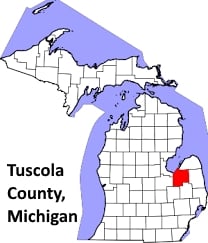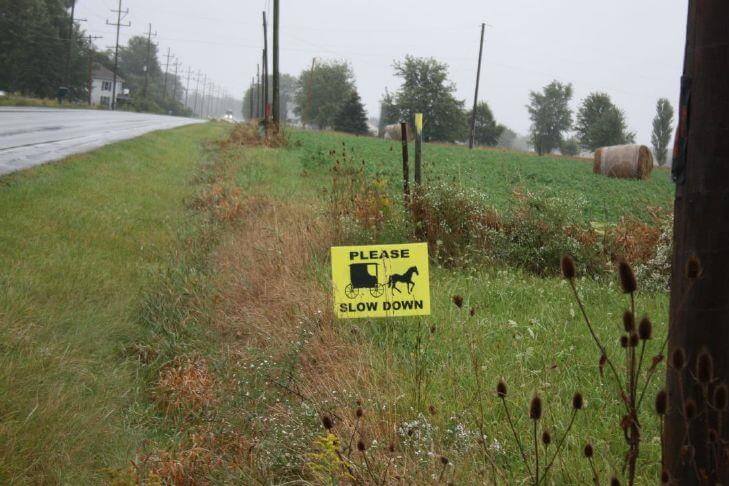Is the SMV Triangle Really the Best Buggy Safety Marking?
In 2011 and 2012, a number of Kentucky Amishmen landed in jail for not carrying an SMV safety triangle on their buggies.
This story got major news attention across the nation. State law was eventually altered to allow reflective tape instead of the triangle, thanks in part to 138 hand-written letters sent by an Amishman to Kentucky legislators.
While the vast majority of Amish use the triangle, a minority do not, notably the Swartzentruber Amish. This lack of a triangle has led to fines, criticism, and as we saw in Kentucky, even imprisonment.

The assumption has often been that the SMV triangle is a necessary–even the best– safeguard providing road visibility. Without an SMV triangle on the buggy, the thinking goes, you are endangering not only yourself but motor vehicle operators.
In a new paper in JAPAS, “Horse and Buggy Crash Study II: Overstretching the Slow-Moving Vehicle Emblem’s Abilities: Lessons from the Swartzentruber Amish,” Cory Anderson investigates this assumption.
His analysis leads to some interesting and even surprising conclusions. You’ll want to read the discussion in full, but I’ll share some of the main points here.
Shortcomings of the SMV triangle
Anderson first reviews the background of SMV triangle usage among Amish, and then analyzes the different indicators that alert drivers to the presence of the buggy.
It is important to note that this analysis focuses on one aspect of buggy visibility–conspicuity, which as Anderson states is the only purpose of the SMV triangle. Illumination and obstruction from view are two separate issues which the SMV triangle does not address.
These conspicuity indicators are the triangle, reflective tape outlining the back borders, and the buggy itself. These can be looked at alone, or in different combinations. Anderson looks at each individually for simplicity.

He makes a number of observations on the three. An obvious one that gets overlooked is that the buggy itself is an indicator, but that it is difficult to see by itself at night, at different times of day, and when obstructed.
Another is that at night, reflective tape is better than the small reflective perimeter of the triangle. And while he credits the orange center of the triangle as better than the tape at attracting attention, he identifies a number of problems with the emblem, including:
- Does not convey info on how much to slow down. When you approach an Amish buggy at speed, the “box” of reflective tape outlining the back borders grows larger to indicate a slower-moving object. The small SMV triangle does not really convey this information.
- Inconsistent appearance. The appearance of the triangle may vary depending on the time of day and distance.
- Inconsistently and illegally used. People put SMV triangles on stationary objects, such as mailboxes or fences, counter to the law. It’s also used on a variety of other vehicles (such as tractors or golf carts), but not always, depending on the state and vehicle.
Does the SMV triangle actually hurt?
Anderson also discusses the most common types of crash situations, including rear-strike collisions (when passing), side impacts, and crashes while buggies are making left turns.
Surprisingly, the SMV triangle may actually contribute to rear-strike collisions:
- Draws attention to center, but does not convey width. The SMV triangle draws our eyes to the center of the vehicle, but does not suggest how wide the vehicle is. This does not help in the common rear-strike collision while passing, and may even hurt (see “moth effect” below).
- The “moth effect”. This was the most surprising piece of information to me. As Anderson writes, “Crash analysts have observed that motorists tend to steer in the direction of a well-lit emergency vehicle on the shoulder at night. The idea is that the carnival of lights attracts too much attention, and the motorist is drawn towards it, like a moth to light in the night (Green 2006).” The triangle teamed with tape and LED lighting may help create a similar result by “draw[ing] too much attention”.
Better solutions?
Anderson then hypothesizes on possible better solutions, particularly for preventing rear-strike impacts, including:
- Tape and lantern. This combination indicates both dimensions of the buggy, and the left-most border of the buggy, potentially more helpful in passing situations. Given the moth effect, is the Swartzentruber pairing of single left-side lantern and reflective tape actually superior to the SMV/LED light combo more standard among Amish (at least in rear-pass situations)?
- Left-mounted or split triangle. Some Amish already do this (for example, when towing a cart). Splitting the emblem in half and placing a piece on each side would help convey width. Hanging it on the left corner would indicate the furthest left dimension.
In his conclusion, Anderson states that while the triangle “may alert drivers to something going on”, it may actually be an “extra step” in processing the object as a horse and buggy.
Furthermore, the triangle “is weak in communicating to the motorist what it represents (a slow-moving vehicle) and how to respond.” And when the motorist does know a buggy is present, such as in passing situations, the emblem is not effective–and may even hurt, given the moth effect.
What do you think? Does this surprise you? What has your experience been on the road with Amish buggies?









Outdated Research and Design?
The now ubiquitous Slow Moving Vehicle Triangle (SMV Triangle) was designed half a century ago by a university president. It was based on research done in the 1950s.
Adoption of the SMV Triangle was promoted by various corporate interests. These included various farm vehicle and tire manufacturers. As much as anything these day, the SMV Triangle may be a money-maker for manufacturers and hardware stores.
Given the above, it is quite possible that the SMV Triangle is outdated. After all, a lot of things have changed since then. Among them, automobile headlamps are different. Like newer household lighting, vehicle headlamps tend to emit light shifted less toward the warmer end of the visible spectrum. Reflection from the SMV Triangle is tilted toward the warmer end of the spectrum.
Long ago, even fire departments recognized that, except for black, no color was harder to see at night than fire engine red! That’s why some departments paint their trucks white while others use that tint of greenish-yellow falling in the middle of the human eye’s visible light spectrum.
Attitudes have also changed. Fewer people live on farms or even have relatives directing dependent on farming to earn a paycheck. They are unfamiliar with the pace of farm life.
Drivers want to get places faster these days. When the SMV Triangle was designed, construction of the Interstate Highway System had just begun. Many drivers were as out of place on an Interstate as commercial pilots trained to fly slower propeller-driven aircraft during World War II were making the transition to faster jet-power airliners – which was occurring about the same time as Interstate Highway construction!
There are also more distracted drivers around. Cell phones are a frequent culprit.
All of the above calls into question the efficacy of the SMV Triangle as the best way to prevent a engine mounted in the front end of a automobile from being unintentionally loaded into the rear end of a slower moving Amish buggy on a rural road.
Interesting
I had never thought of it that way, but it makes a lot of sense to me (although, admitted as one who has not done much night driving around Amish buggies). I can certainly see how the stark difference of a single bright object (SMV triangle) can cause a form of tunnel vision that even further obscures the black-on-black (buggy against the night) vehicle border, and could make it easier to ‘clip’ the buggy that a driver thought he had cleared as he attempted to pass. The vehicle-dimensional benefit of the reflective tape seems like sound reasoning to me.
In short, I think this guy may be on to something.
It is always interesting to see there are non-Amish people researching things Amish people give very little thought to. For people my age the SMV is just as much a part of the buggy as the shafts. I do see Swartzentrubers in our area driving buggies without SMVs and with lanterns and feel they are being disrespectful to other people sharing the road. We live in a community that gets nearly 5 million tourists a year. Some of these visitors are not prepared for buggies without SMVs or lights and get a scare to come on one when they are not expecting it. At the same time I believe they have the right to try & keep their Ordnung. I wish there could be a compromise.
The article could mention that most buggies do have tape outlining the top and some put tape on the outer hub so the width of the axle is seen after dark. Add a flasher on the middle of the top edge and it’s easy to see a regular buggy after dark. We also have 2 tailights at the outside of the top on the back.
It seems to me many accidents are caused not by tourists but by local people in a hurry. I often hear tourists talk about how shocked they are to see how some locals drive around buggies. I guess they are more used to buggies, the roads (hills & risky areas) and probably get more frustrated at being held up in traffic.
I think one thing that would help buggy safety in Holmes Co. is to have a more standard idea of buggy lighting. A visitor might drive behind a higher buggy with all kinds of lights and blinkers then a few miles later come up behind a Swartz. buggy with no trianle or lights. Confusing, not? But with 11 kinds of Amish in this community, there is a variety of lighting standards.
How do people react generally when they encounter safety triangles on things like motorized tractors and other non-Amish vehicles which are equally as slow in their speed?
I mean even if you travel around a medium size city you will see a number of vehicles equipped with safety triangles identical to the ones used by the Amish and Mennonites yet these are not considered out of date…
SMV Triangle vs. Reflective Tape
I think all slow moving vehicles, motorized or not, should have reflective tape marking the width of the vehicle. As an example, and speaking from experience, I was driving on an unlit two lane highway in IL and almost hit a HUGE hopper full of grain that was being pulled by a tractor. I couldn’t see the SMV triangle on the hopper until I was practically ON it. Reflective tape would have been visible from a far greater distance. If it’s good enough to be used on school buses, semi truck emergency triangles, bikes, joggers, and dog leashes then why not use it to mark the width of an Amish buggy? A buggy never wins when it’s in a crash with a car or truck. Reflective tape seems like a simple solution when lives are at stake.
In our community reflective tape is put on the outline of the back of a buggy. You’re right — the reflector tape shows up better than the triangle. We also have reflector tape on the side of the buggy: a stripe on the box between the front & rear wheels and a stripe on the top edge front & rear. Some people put a stripe on the top of the front, but more & more use little LED lights on the top front. Besides tape on the top & box, more & more harnesses are being made with reflective bands sewn right on. Our one harness has such bands on the nose & brow band and a stripe on each shaft carrier.
I realize people living in different areas will see variations and be used to buggies with less or in some cases more lights & reflectors than we use in our group or our community.
Why do some Amish object to battery lights of triangles? Most of those using lanterns on buggies also do without pressurized lighting or battery lighting in their homes. I know of one community that does not even allow flashlights, so for them using a battery lighted buggy would be out of their “comfort zone.” Those groups tend to change very slowly, if at all.
I know a Swartzentruber man who told me the main reason they object to the SMV is the bright colors and they see where churches like ours who did get the SMV made a lot of other changes to their buggies also — so they take a “warning” and consider most changes as being “risky.” The same guy told me he burns paint-thinner in his lanterns on his buggy because it burns cleaner. That surprised me.
What's the reason??
What is the Amish reasoning that the buggies should not have some form of warning signs/symbols/lights on them? I know it comes from how they read the Ordnung, but what is the specific reason?
Tom in Lincoln, NE
The SMV Triangle is on the back. There is nothing on the sides of the buggy. If you are driving at night and are on a side road coming up to a main road with a buggy on it, it is hard to see the buggy. There is nothing on the side of the buggy. Been there. Done that. Knowing that buggies are in the area I was driving, I was careful. But someone not familiar with the area could have an accident.
Marilyn
Safety Markings for Buggies
I have no trouble spotting a Swartzentruber buggy at night, as long as I’m approaching from the rear. In this area (Oswego County, New York), the Amish also use lanterns on the left sides of their buggies, to some effect, although they’re pretty dim when sooty, and they use a small strip (about 4″) of reflective tape on the front. I have suggested that they consider applying 3 or 4 tape strips on the front like those on the back, but doubt that will occur (at least, in my lifetime!).
I guess I should have put that comment on the bottom, because I was replying to several people’s comments.
Indicate the horses too
What about reflective straps around the ankles of the horses?
Bicyclists wearing pants often use such straps to hold the pant cuffs tight on the ankle, so the cuffs don’t get stained or caught by the drive chain. The reflective material provides night visibility, and the cycling motion of the reflectors hints that a driver is seeing a cyclist.
The distinctive motion of horse hooves would likewise hint to drivers that they are seeing horses. That in turn would suggest that drivers are seeing a slow-moving object.
But that “moth effect” presumably would counter those advantages.
Special horses
I agree with the commenter who says the horses need to be visible in the dark as well as the carriages. Folks, why not breed special glow-in-the-dark horses? It could be pretty easily done; like a mule is made by breeding a donkey with a horse, these special horses could be bred by mixing a unicorn with a horse.
Alternatively, you could simply mix in some radium with their oats.
Oops…I hope I haven’t given away any trade secrets…
Hey, Horseman, you might be on to something! Is it to early to place an order for a glow-in-the-dark horse? 🙂
Hey, Mark in Holmes County
Mark,
Well, so far, we’re still working on the prototype. We had some issues because we fashioned it from a zebra and a unicorn. We thought that the stripes would help with visibility, but as it turned out, when picked up by the headlights of a car, it looked a lot like a crosswalk. Back to the drawing board.
PS: We’re also looking into the feasibility of using a pegasus-unicorn mix for marketing to the more-liberal Amish and Mennonite sects whose ordnung does not forbid flying. So if you know of any animal-husbandry experts in the larger “plain” community who would be interested in acting as a subcontractor in the breeding of this model, please let us know.
Well, a striped horse would be just a bit too splashy for my liking and the unicorn’s horn would make bridling up a bit tricky and I’m not interested in flying, so I think I’ll pass, but if hear of anyone interested, I’ll let you know. 🙂